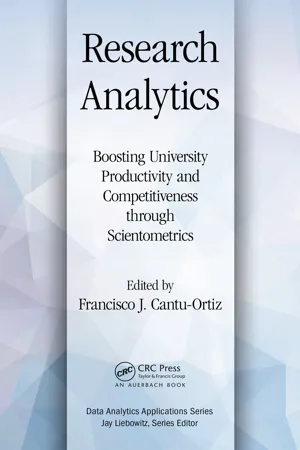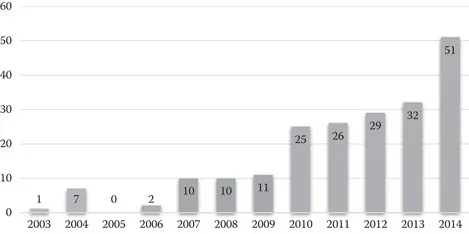
Research Analytics
Boosting University Productivity and Competitiveness through Scientometrics
- 264 pages
- English
- ePUB (mobile friendly)
- Available on iOS & Android
Research Analytics
Boosting University Productivity and Competitiveness through Scientometrics
About This Book
The growth of machines and users of the Internet has led to the proliferation of all sorts of data concerning individuals, institutions, companies, governments, universities, and all kinds of known objects and events happening everywhere in daily life. Scientific knowledge is not an exception to the data boom. The phenomenon of data growth in science pushes forth as the number of scientific papers published doubles every 9–15 years, and the need for methods and tools to understand what is reported in scientific literature becomes evident.
As the number of academicians and innovators swells, so do the number of publications of all types, yielding outlets of documents and depots of authors and institutions that need to be found in Bibliometric databases. These databases are dug into and treated to hand over metrics of research performance by means of Scientometrics that analyze the toil of individuals, institutions, journals, countries, and even regions of the world.
The objective of this book is to assist students, professors, university managers, government, industry, and stakeholders in general, understand which are the main Bibliometric databases, what are the key research indicators, and who are the main players in university rankings and the methodologies and approaches that they employ in producing ranking tables.
The book is divided into two sections. The first looks at Scientometric databases, including Scopus and Google Scholar as well as institutional repositories. The second section examines the application of Scientometrics to world-class universities and the role that Scientometrics can play in competition among them. It looks at university rankings and the methodologies used to create these rankings. Individual chapters examine specific rankings that include:
- QS World University
- Scimago Institutions
- Webometrics
- U-Multirank
- U.S. News & World Report
The book concludes with a discussion of university performance in the age of research analytics.
Frequently asked questions
Information
IIApplication of Scientometrics to University Competitiveness and World-Class Universities
6Academic Ranking of World Universities (ARWU): Methodologies and Trends
6.1Introduction
6.1.1ARWU: Born for the Chinese Dream
6.1.2Drawing Global Attention

Table of contents
- Cover
- Half Title Page
- Series Page
- Title Page
- Copyright Page
- Dedication
- Contents
- Foreword
- Preface
- Acknowledgments
- Editor
- Author
- Section I Scientometric Databases
- Section II Application of Scientometrics to University Competitiveness and World-Class Universities
- Index